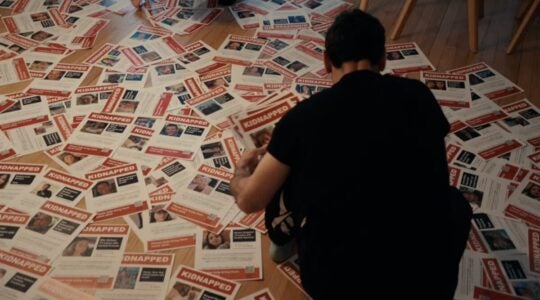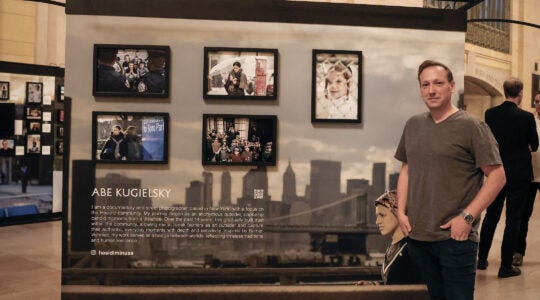Depending on your perspective, Sunday night’s "60 Minutes" segment on Tel Aviv either was a spot-on look at Israel’s greatest city, a cliche-filled mockery (the Forward’s Gal Beckerman), or penance for Bob Simon’s recent segment on Christians in the Holy Land (Honest Reporting).
The real question is whether Tel Aviv or Jerusalem represents the true Israel.
There’s a long-running dispute among Israelis about which city better represents Israel ’s true face: Tel Aviv or Jerusalem.
One is a symbol of the historical and religious yearning of the Jewish people, the country’s political capital and a microcosm of the state’s divisions: religious and secular, Arab and Jewish, rich and poor.
The other has comparatively little historical baggage, looks more like Mediterranean Europe than the Middle East, prizes secular culture and liberalism more than it does tradition and religion, and is the country’s cultural capital.
[[READMORE]]
Sha’anan Streett, founder and lead singer of the popular Israeli hip-hop band Hadag Nahash, sings about being pulled between these twin poles of Israeli society in the band’s hit song “Hine Ani Ba” (“Here I Come”).
“Jerusalem’s a great city,” the character in the song begins, singing the city’s praises: “Walking on the street feels like the ingathering of the exiles, a thousand cultures.” But then he grows disenchanted with the city – “it’s gray, there’s no beach” – and packs up for the bright lights of Tel Aviv. At first he finds that “everything’s fresh, and that’s good,” but “after two years of Sodom and Gemorrah,” he doesn’t recognize himself anymore and yearns to return to Jerusalem.
He promises both cities: “You’re the only one – I swear!”
In an interview with me in 2009, Streett, who lives in Jerusalem, said Tel Aviv unquestionably is the symbol of Israel and Israeliness today.
“Jerusalem expresses the Middle East, the people who live in the Middle East, and the religions that exist in the Middle East — and the appeasement and conflict between all the elements that live here,” Street said. “But Tel Aviv is the most Hebrew city that exists here. Tel Aviv is the expression of the dreams of most of the people who live in Israel. They dream of making it big in Tel Aviv, of being successful in Tel Aviv. They don’t dream of being a success in Jerusalem.”
Two public demonstrations on back-to-back weekends in 2009 epitomized the differences between the two cities. (This piece is based on reporting I did in 2009 for a story on Tel Aviv’s 100th anniversary).
When Tel Aviv held its annual gay pride parade in mid-June 2009, Mayor Ron Huldai was at the center of the festive, irreverent celebration, which drew thousands of party-goers and culminated in the mayor’s presiding over a sunset wedding on the city’s Gordon Beach for five gay couples. The weddings were not official; Israel does not recognize gay marriage.
“I hope the state of Israel and the Knesset will find a way to change the laws and permit same-sex marriages,” Huldai said as a cheer rippled through the crowd. “Today we have seen a major step forward.”
A week earlier, Jerusalem also saw thousands take to the streets – for a rally that drew thousands of haredi Orthodox Israelis protesting the opening on the Sabbath of a parking lot near the Old City. The demonstration, which Israeli media described as a riot, prompted the city’s police chief to ask Mayor Nir Barkat to shut down the parking garage for the next two Saturdays, until a plan for keeping the peace could be put in place. Barkat agreed.
Those different crowds on back-to-back weekends in Israel’s two largest cities were a symbol of the gulf that lies between 3,000-year-old Jerusalem and 100-year-old Tel Aviv, though the two cities are only a 50-minute car ride apart.
“I used to say: If I live in Israel, I want to live in Jerusalem – or on a kibbutz or a moshav – and there’s no reason to live in Tel Aviv, which after all aspires to be New York or London,” said Oren Harman, a scion of one of Jerusalem’s prominent families. “I was wrong. In Tel Aviv, the first Hebrew city, there is something very Israeli about it. Tel Aviv is a lot closer to what Israelis think of as Israeli than Jerusalem is.”
But Yuval Turm, a physician from Shoresh, a suburb of Jerusalem, says Tel Aviv is not the real Israel.
“Jerusalem is really a balagan,” Turm said, using the Hebrew word for hullabaloo. “Tel Aviv is more ordered. It looks more like a European city. It’s not really Israeli.”
Many Israelis, from the hills of Judea to the kibbutzim of the Negev, identify Tel Aviv with all that’s wrong with contemporary Israel: creeping materialism, a dearth of Zionism, detachment from the travails of those who live in Israel’s conflict zones, near Gaza and Lebanon.
“Their willingness to contribute to the state is zero,” an outgoing police chief in the West Bank, Shlomo Katabi, said of Tel Avivis in a June 2009 interview with Army Radio. “They sit in Tel Aviv, park their SUVs on Sheinkin Street, drink espresso with their legs crossed and allow themselves to criticize [Jewish settlers in the West Bank].”
Katabi’s barb against Tel Aviv was emblematic of the irritation many feel about the city, a stronghold of the political left and a place where the rate of IDF service is below average. Even though military service is mandatory in Israel, it’s relatively easy to evade the draft — by declaring mental incompetence, providing a doctor’s letter attesting to physical disabilities or objecting from serving on pacifistic grounds. While the rate nationally of draft-age Israeli males who do not serve is about 25 percent, in Tel Aviv it is approximately 30 percent, according to the IDF.
When southern Israel came under fire during Israel’s 2009 military operation in Gaza — with cities including Beersheva, Ashdod and Yavne suffering rocket strikes – Israeli media was filled with commentators decrying the lack of concern among Tel Avivis.
Much of this was scapegoating, of course – the war wasn’t readily palpable in Jerusalem , either, and people there, too, were sipping espressos at cafes – but Tel Aviv stood as the symbol of Israeli disconnectedness.
By the same token, many Tel Avivis look down their noses at Jerusalem – and by extension, the rest of the country — as parochial, uncultured and fraught with conflict.
“Tel Aviv has become some kind of antithesis to all this,” said Yehuda Melzer, a philosophy professor and founder of the small Tel Aviv publishing house Books in the Attic (Sifrei Aliyat Hagag). “One of the great attractions of Tel Aviv is that it’s so unlike Jerusalem.”
Tel Aviv is an “oasis of normalcy in an insane country,” wrote Gideon Levy, a columnist for Israel’s daily Haaretz, in a scathing response to Katabi’s barb about Tel Avivis. “Between the espresso and the SUV arise art, culture, finance, science, intellect, media, openness and a healthy (albeit insufficient) introspection of the State of Israel, without which it has no real backbone.” [Incidentally, Levy had a much less nuanced perspective in the "60 Minutes" segment.]
For his part, Tel Aviv’s mayor rejects the notion that his city is detached from the rest of Israel.
“I completely don’t see Tel Aviv as bubble, but as representative of mainstream Israel ,” said Huldai, who has been mayor since 1998. “By the same token one can say that Jerusalem is a bubble, one can say that the Negev is a bubble, one can say that the Galilee is a bubble,” he said. “We are all one state.”
Watch the "60 Minutes" segment for yourself here:
CORRECTION: This post has been updated to correct a mischaracterization of Harry Rubenstein’s reaction to the "60 Minutes" report. He did not think it was spot on; he thought Beckerman’s critique of it was spot on. Take that, Bob Simon!
JTA has documented Jewish history in real-time for over a century. Keep our journalism strong by joining us in supporting independent, award-winning reporting.





